2014 PEUGEOT 4008 wheel
[x] Cancel search: wheelPage 153 of 368
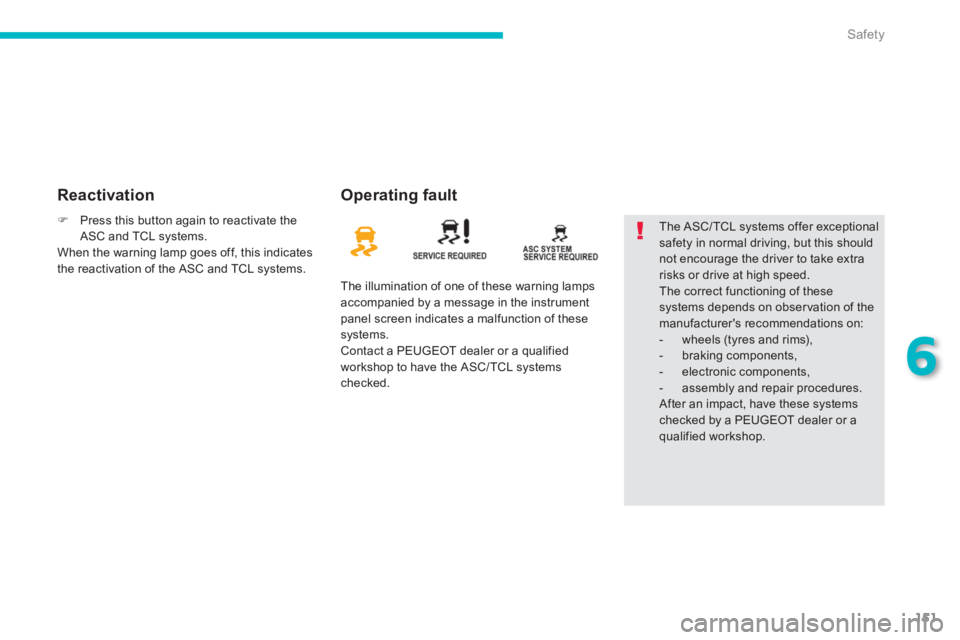
151
6
Safety
Reactivation
Operating fault
The illumination of one of these warning lamps
accompanied by a message in the instrument
panel screen indicates a malfunction of these
systems.
Contact a PEUGEOT dealer or a qualified
workshop to have the ASC/ TCL systems
checked. The ASC/ TCL systems offer exceptional
safety in normal driving, but this should
not encourage the driver to take extra
risks or drive at high speed.
The correct functioning of these
systems depends on obser vation of the
manufacturer's recommendations on:
- wheels (tyres and rims),
- braking components,
- electronic components,
- assembly and repair procedures.
After an impact, have these systems
checked by a PEUGEOT dealer or a
qualified workshop.
�)
Press this button again to reactivate the
ASC and TCL systems.
When the warning lamp goes off, this indicates
the reactivation of the ASC and TCL systems.
Page 158 of 368

156
Safety
Airbags
System designed to maximise the safety of the
occupants (with the exception of the rear centre
passenger) in the event of violent collisions.
The airbags supplement the action of the force-
limiting seat belts (with the exception of the
centre rear passenger).
If a collision occurs, the electronic detectors
record and analyse the front and side impacts
sustained in the impact detection zones:
- in the case of a serious impact, the airbags
are deployed instantly and contribute
towards better protection of the occupants
of the vehicle (with the exception of the
rear centre passenger); immediately after
the impact, the airbags deflate rapidly so
that they do not hinder visibility or the exit
of the occupants,
- in the case of a minor or rear impact
or in certain roll-over conditions, the
airbags will not be deployed; the seat belt
alone contributes towards ensuring your
protection in these situations.
The airbags do not operate when the
ignition is switched off.
This equipment will only deploy once.
If a second impact occurs (during the
same or a subsequent accident), the
airbag will not be deployed again. Deployment of the airbag(s) is
accompanied by a slight emission
of smoke and a noise, due to the
activation of the pyrotechnic cartridge
incorporated in the system.
This smoke is not harmful, but sensitive
individuals may experience slight
irritation.
The noise of the detonation may result
in a slight loss of hearing for a short
time.
Impact detection zones
A.
Front impact zone.
B.
Side impact zone.
Front airbags
Deployment
The airbags are deployed, except the
passenger's front airbag if it is deactivated,
in the event of a serious front impact applied
to all or part of the front impact zone A
, in
the longitudinal centreline of the vehicle on a
horizontal plane and directed from the front to
the rear of the vehicle.
The front airbag inflates between the front
occupant of the vehicle and the dashboard to
cushion their for ward movement. System which protects the head and chest of
the driver and front passenger in the event of a
front impact.
The driver's airbag is fitted in the centre of the
steering wheel; the front passenger's airbag is
fitted in the dashboard above the glove box.
Page 162 of 368
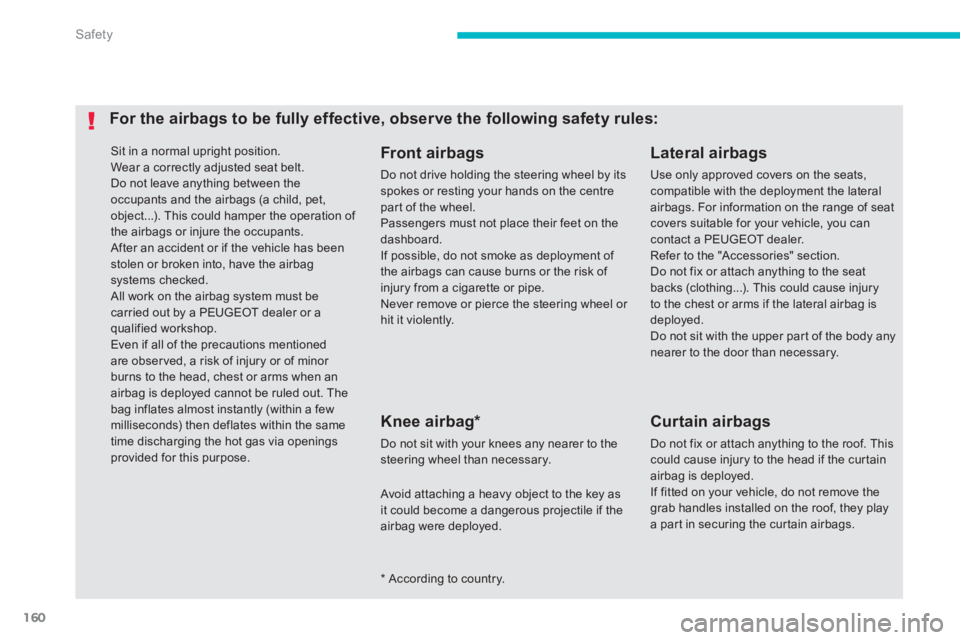
160
Safety
Sit in a normal upright position.
Wear a correctly adjusted seat belt.
Do not leave anything between the
occupants and the airbags (a child, pet,
object...). This could hamper the operation of
the airbags or injure the occupants.
After an accident or if the vehicle has been
stolen or broken into, have the airbag
systems checked.
All work on the airbag system must be
carried out by a PEUGEOT dealer or a
qualified workshop.
Even if all of the precautions mentioned
are obser ved, a risk of injury or of minor
burns to the head, chest or arms when an
airbag is deployed cannot be ruled out. The
bag inflates almost instantly (within a few
milliseconds) then deflates within the same
time discharging the hot gas via openings
provided for this purpose.
Knee airbag *
Do not sit with your knees any nearer to the
steering wheel than necessary.
Front airbags
Do not drive holding the steering wheel by its
spokes or resting your hands on the centre
part of the wheel.
Passengers must not place their feet on the
dashboard.
If possible, do not smoke as deployment of
the airbags can cause burns or the risk of
injury from a cigarette or pipe.
Never remove or pierce the steering wheel or
hit it violently.
For the airbags to be fully effective, observe the following safety rules:
Lateral airbags
Use only approved covers on the seats,
compatible with the deployment the lateral
airbags. For information on the range of seat
covers suitable for your vehicle, you can
contact a PEUGEOT dealer.
Refer to the "Accessories" section.
Do not fix or attach anything to the seat
backs (clothing...). This could cause injury
to the chest or arms if the lateral airbag is
deployed.
Do not sit with the upper part of the body any
nearer to the door than necessary.
*
According to country.
Curtain airbags
Do not fix or attach anything to the roof. This
could cause injury to the head if the curtain
airbag is deployed.
If fitted on your vehicle, do not remove the
grab handles installed on the roof, they play
a part in securing the curtain airbags.
Avoid attaching a heavy object to the key as
it could become a dangerous projectile if the
airbag were deployed.
Page 179 of 368
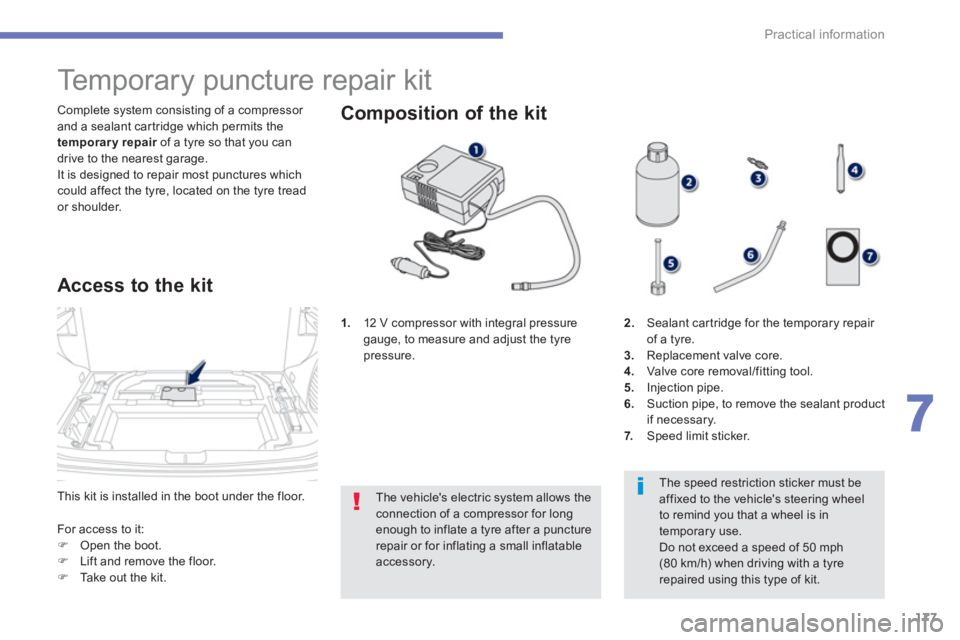
177
7
Practical information
This kit is installed in the boot under the floor. Complete system consisting of a compressor
and a sealant cartridge which permits the
temporary repair
of a tyre so that you can
drive to the nearest garage.
It is designed to repair most punctures which
could affect the tyre, located on the tyre tread
or shoulder.
Temporary puncture repair kit
Access to the kit
1.
12 V compressor with integral pressure
gauge, to measure and adjust the tyre
pressure.
For access to it:
�)
Open the boot.
�)
Lift and remove the floor.
�)
Take out the kit.
Composition of the kit
The speed restriction sticker must be
affixed to the vehicle's steering wheel
to remind you that a wheel is in
temporary use.
Do not exceed a speed of 50 mph
(80 km/h) when driving with a tyre
repaired using this type of kit.
2.
Sealant cartridge for the temporary repair
of a tyre.
3.
Replacement valve core.
4.
Valve core removal/fitting tool.
5.
Injection pipe.
6.
Suction pipe, to remove the sealant product
if necessary.
7.
Speed limit sticker.
The vehicle's electric system allows the
connection of a compressor for long
enough to inflate a tyre after a puncture
repair or for inflating a small inflatable
accessory.
Page 180 of 368
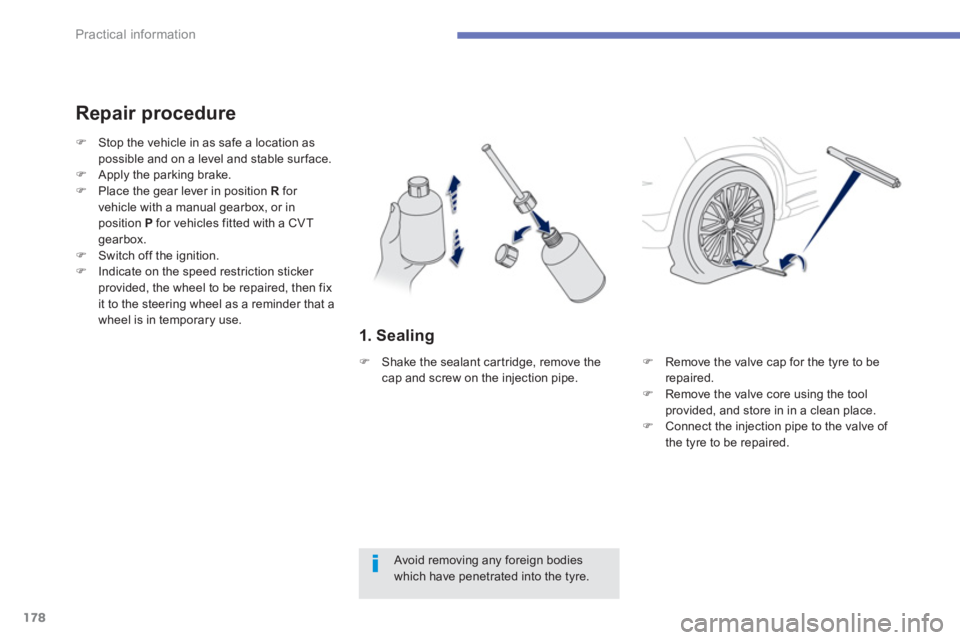
178
Practical information
1. Sealing
Repair procedure
Avoid removing any foreign bodies
which have penetrated into the tyre.
�)
Stop the vehicle in as safe a location as
possible and on a level and stable sur face.
�)
Apply the parking brake.
�)
Place the gear lever in position R
for
vehicle with a manual gearbox, or in
position P
for vehicles fitted with a CVT
gearbox.
�)
Switch off the ignition.
�)
Indicate on the speed restriction sticker
provided, the wheel to be repaired, then fix
it to the steering wheel as a reminder that a
wheel is in temporary use.
�)
Remove the valve cap for the tyre to be
repaired.
�)
Remove the valve core using the tool
provided, and store in in a clean place.
�)
Connect the injection pipe to the valve of
the tyre to be repaired.
�)
Shake the sealant cartridge, remove the
cap and screw on the injection pipe.
Page 182 of 368
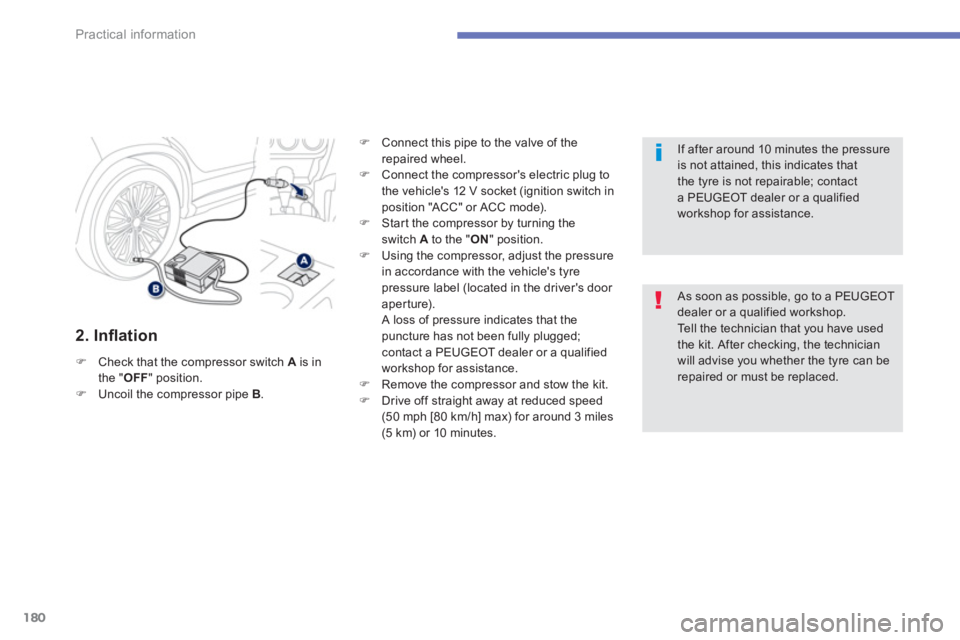
180
Practical information
2. Infl ation
�)
Check that the compressor switch A
is in
the " OFF
" position.
�)
Uncoil the compressor pipe B
.
�)
Connect this pipe to the valve of the
repaired wheel.
�)
Connect the compressor's electric plug to
the vehicle's 12 V socket (ignition switch in
position "ACC" or ACC mode).
�)
Start the compressor by turning the
switch A
to the " ON
" position.
�)
Using the compressor, adjust the pressure
in accordance with the vehicle's tyre
pressure label (located in the driver's door
aperture).
A loss of pressure indicates that the
puncture has not been fully plugged;
contact a PEUGEOT dealer or a qualified
workshop for assistance.
�)
Remove the compressor and stow the kit.
�)
Drive off straight away at reduced speed
(50 mph [80 km/h] max) for around 3 miles
(5 km) or 10 minutes.
As soon as possible, go to a PEUGEOT
dealer or a qualified workshop.
Tell the technician that you have used
the kit. After checking, the technician
will advise you whether the tyre can be
repaired or must be replaced.
If after around 10 minutes the pressure
is not attained, this indicates that
the tyre is not repairable; contact
a PEUGEOT dealer or a qualified
workshop for assistance.
Page 183 of 368
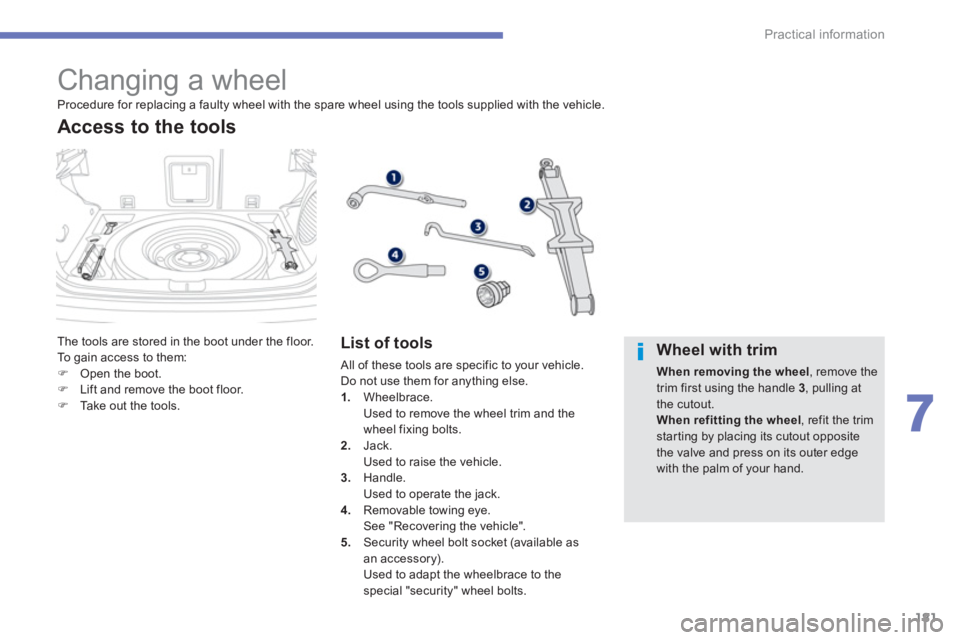
181
7
Practical information
Changing a wheel
The tools are stored in the boot under the floor.
To gain access to them:
�)
Open the boot.
�)
Lift and remove the boot floor.
�)
Take out the tools.
Access to the tools
List of tools
All of these tools are specific to your vehicle.
Do not use them for anything else.
1.
Wheelbrace.
Used to remove the wheel trim and the
wheel fixing bolts.
2.
Jack.
Used to raise the vehicle.
3.
Handle.
Used to operate the jack.
4.
Removable towing eye.
See "Recovering the vehicle".
5.
Security wheel bolt socket (available as
an accessory).
Used to adapt the wheelbrace to the
special "security" wheel bolts.
Procedure for replacing a faulty wheel with the spare wheel using the tools supplied with the vehicle.
Wheel with trim
When removing the wheel
, remove the
trim first using the handle 3
, pulling at
the cutout.
When refitting the wheel
, refit the trim
starting by placing its cutout opposite
the valve and press on its outer edge
with the palm of your hand.
Page 184 of 368
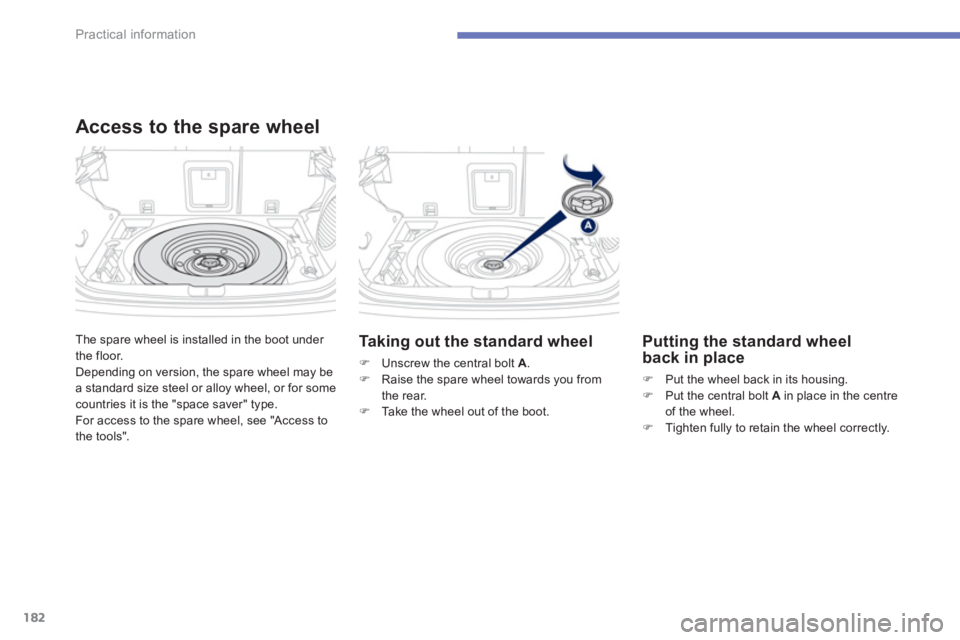
182
Practical information
The spare wheel is installed in the boot under
the floor.
Depending on version, the spare wheel may be
a standard size steel or alloy wheel, or for some
countries it is the "space saver" type.
For access to the spare wheel, see "Access to
the tools".
Access to the spare wheel
Taking out the standard wheel
�)
Unscrew the central bolt A
.
�)
Raise the spare wheel towards you from
the rear.
�)
Take the wheel out of the boot.
Putting the standard wheel
back in place
�)
Put the wheel back in its housing.
�)
Put the central bolt A
in place in the centre
of the wheel.
�)
Tighten fully to retain the wheel correctly.